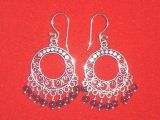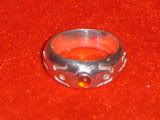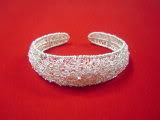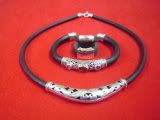Putri Dewi Silver has been engaged in providing a broad range of good quality silver. We provide the best quality silver jewelry and passionate design including necklaces, bracelets, rings, pendants, beadeds, and earrings directly from Balinese hand.
Putri Dewi silver is one of the well known jewellery shop in Bali which is located in Celuk. As we know Celuk has be known as the center of the gold and silver jewelry industry in Bali, its jewellery shop and for sure, with so many talented jewelers,too. No doubt, many visitors who comes from another countries willing to spent their times to come and see every single jewellery shop in this area.
Putri Dewi silver which established in 1998 for the first time and managered by I Nyoman Purna who was born as the generation of Pande. As a briefly historical, Pande generation is a religious generation in bali who always born as the jeweler. They are all alive to make a jewellery and also relationship with iron/steel stuff like kris, tombac, etc.
All our products are made from 92.5 sterling silver and individually handcrafted by our own highly skilled silversmith in Bali, Indonesia. The retail and wholesale Bali silver in this web site are handmade in Bali, a small island in the Indonesian, which is renowned for its artistic and cultural heritage.
Balinese artists are well known have perfected their skills. As a result, our products display quality technique and immense patience. Each design is carefully made with exquisite detail. Every silver dot is individually placed, every surface patterned by hand. Each bead is a work of art.
Tuesday, June 17, 2008
About Us
Diposkan oleh
putridewi silver
10:00 PM
Thursday, June 12, 2008
What is Sterling Silver?
Diposkan oleh
putridewi silver
3:29 AM
Silver is somewhat rare and expensive, although not as expensive as gold. Slag dumps in Asia Minor and on islands in the Aegean Sea indicate that man learned to separate silver from lead as early as 3000 B.C. Pure silver has a brilliant white metallic lustre. It is a little harder than gold and is very ductile and malleable. Pure silver has the highest electrical and thermal conductivity of all metals, and possesses the lowest contact resistance. Silver iodide, AgI, is (or was?) used for causing clouds to produce rain.
Sterling Silver is 92.5% silver and 7.5% copper. 99.9% silver is called "Fine silver." Sterling components and jewelry made in the USA are often stamped "Sterling." Goods made for international trade are often marked "925" indicating the 92.5% fineness. "Coin" silver is used in some countries and could be marked "900" or "800" depending on fineness.
Other silver standards
Fine silver is 99.9% silver or better. This grade of silver is used to make bullion bars for international commodities trading. In the modern world Fine Silver is understood to be too soft for general use.
Britannia silver is purer than sterling, at least 95.84% silver and up to 4.16% copper. Its marks were Britannia and a lion's head in profile.
The Britannia standard was a standard of plate obligatory in Britain between 1697 and 1720 to try to help prevent British sterling silver coins from being melted to make plate. It became an optional standard thereafter, and in the United Kingdom and Ireland is now denoted by the millesimal fineness hallmark "958", with the symbol of Britannia being applied optionally.
Mexican silver is also purer than sterling, usually 95% Silver and 5% Copper. Mexico is the only country currently using silver in its circulating coinage, but these coins are not minted from 95% "Mexican" Silver. Much of the currently produced silver jewelry and other decorative silver objects made in Mexico at the present time are made according to the Sterling, i.e. 92.5% silver, standard, and are marked "Sterling".
Coin silver is most commonly 90% silver and 10% copper as dictated by United States FTC guidelines. "Coin Silver" is said to have acquired its name because much of it was made from melting down silver coins, which are generally of the 90% standard. This does allow for some variation in the silver content, depending on which coinage was used to create the silver stock.
Coin silver is usually lower in silver content than sterling. The Coin standard came into common use for table silver in the US during the 1820s, and lasted until 1868. This grade of silver was used in the silver coinage of the US, (until 1964) and also by other countries that minted silver currency , such as Panama and the Philippines.
German silver (not to be confused with nickel silver, which is also referred to by this same term) are several silver standards used in Germany. However, the most common standard for flatware and decorative silver objects is the 800 standard (80% pure silver). Hence, when the term German silver is used, it is usually referred to as the 800 standard. Another silver standard in use is the 900 standard. German silver objects are usually marked with an "800" or "900" to show the standard to which they are made.
For industrial uses, for example in electronics, alloys such as copper-silver, CuAg, are favored, which contains 72% silver and 28% copper and is known for its thermal conductivity.
History of sterling silver and dining regalia
19th Century Tiffany & Co. Pitcher. Circa 1871. Pitcher has paneled sides, and repousse design with shells, scrolls and flowers. Top edge is repousse arrowhead leaf design.
From about 1840 to somewhere around 1940 in the United States and Europe, sterling silver flatware became de rigeur when setting a proper table. In fact, there was a marked increase in the number of silver companies that emerged during that period.
The height of the silver craze was during the 50-year period from 1870 to 1920. Flatware lines during this period sometimes included up to 100 different types of pieces. In conjunction with this, the dinner went from three courses to sometimes ten or more. There was a soup course, a salad course, a fruit course, a cheese course, an antipasto course, a fish course, the main course and a pastry or dessert course.
Individual eating implements often included forks (dinner fork, place fork, salad fork, pastry fork, shrimp or cocktail fork, terrepin fork), spoons (teaspoon, coffee spoon, demitasse spoon, bouillon spoon, gumbo soup spoon, iced tea spoon) and knives (dinner knife, place knife, butter spreader, fruit knife, cheese knife). This was especially true during the Victorian time period, when etiquette dictated that nothing should be touched with one's fingers.
Serving pieces were often elaborately decorated and pierced and embellished with ivory, and could include any or all of the following: carving knife and fork, salad knife and fork, cold meat fork, punch ladle, soup ladle, gravy ladle, casserole serving spoon, berry spoon, lasagna server, macaroni server, asparagus server, cucumber server, tomato server, olive spoon, cheese scoop, fish knife and fork, pastry server, petit four server, cake knife, bon bon spoon, sugar sifter or caster and crumb remover with brush.
Flatware sets were often accompanied by tea services, hot water pots, chocolate pots, trays and salvers, goblets, demitasse cups and saucers, liqueur cups, bouillon cups, egg cups, sterling plates, napkin rings, water and wine pitchers and coasters, candelabra and even elaborate centerpieces.
In fact, the craze with sterling even extended to business (sterling page clips, mechanical pencils, calling card boxes, cigarette cases), to the boudoir (sterling dresser trays, mirrors, hair and suit brushes, pill bottles, manicure sets, shoe horns, perfume bottles, powder bottles, hair clips) and even to children (cups, flatware, rattles, christening sets).
A number of factors converged to make sterling fall out of favor around the time of World War II. The cost of labor rose (sterling pieces were all still mostly man-made, with only the basics being done by machine). Only the wealthy could afford the large number of servants required for fancy dining with ten courses. And changes in aesthetics resulted in people desiring simpler dinnerware that was easier to clean. (The latter was especially important as more became known about disease.)Wednesday, June 11, 2008
Silverwork
Diposkan oleh
putridewi silver
12:07 AM
Silverwork utilitarian objects and works of art created from silver. Silverwork includes ecclesiastical and domestic plate, flatware, jewelry, buttons, buckles, boxes, toilet articles, weapons, furniture, and horse trappings. It involves a variety of embellishments, such as chasing, repoussé, filigree, and inlaying, which have engaged the talents of skilled artisans since prehistoric times.
Ancient Silverwork
Silverwork was highly developed among the ancients as is evidenced by treasures and funeral objects from Egyptian tombs; Minoan silver cups, seals, and ornaments of c.2000 BC; and silver vases and the inlays on bronze blades of Mycenae. Work attributed to the Phoenicians has been found in Greece, where early native examples
European Silverwork
Much Italian and French silverwork was melted down for reuse and thus lost. Early German Renaissance silverwork is less abundant than that of the 16th cent. from the two most prolific centers, Augsburg and Nuremberg, with their numerous Italian artisans. German characteristics prevail in Swiss silverwork, and the influence extended to Spain but was overbalanced by the presence of many Italian artisans there in the 15th cent.
Spanish silver of the 16th cent. carries elaborate designs, and in the 17th cent. silversmiths added filigree and enamel to the decoration. A Spanish architectural style of the 16th cent. is called plateresque for its profusion of ornate motifs similar to the work of the silversmiths of that period. Much fine 17th- and 18th-century Dutch silver shows designs in the French taste. Poland and Russia produced ecclesiastical plate, domestic ware, and horse trappings.
The Reformation brought destruction to ecclesiastical art of N Europe, and much plate was melted down in England during the Wars of the Roses so that little early English silver is extant. The hallmark came into use c.1300. Elizabethan pieces display German influence, and work of the period of Charles II is loaded with ornament. Cromwellian influence is reflected in English silverwork of extreme simplicity; French tendencies of the Louis XIV regime contributed great enrichment and were followed by the later rococo style; under Robert Adam 's influence there was a classic reaction. Sheffield plate was an innovation of the 18th cent.; since then plated ware has become the product of important industries in England and the United States. The modern revival of hand-wrought silver was influenced by the severe forms
of Danish work.
European Silverwork
Much Italian and French silverwork was melted down for reuse and thus lost. Early German Renaissance silverwork is less abundant than that of the 16th cent. from the two most prolific centers, Augsburg and Nuremberg, with their numerous Italian artisans. German characteristics prevail in Swiss silverwork, and the influence extended to Spain but was overbalanced by the presence of many Italian artisans there in the 15th cent.
Spanish silver of the 16th cent. carries elaborate designs, and in the 17th cent. silversmiths added filigree and enamel to the decoration. A Spanish architectural style of the 16th cent. is called plateresque for its profusion of ornate motifs similar to the work of the silversmiths of that period. Much fine 17th- and 18th-century Dutch silver shows designs in the French taste. Poland and Russia produced ecclesiastical plate, domestic ware, and horse trappings.
The Reformation brought destruction to ecclesiastical art of N Europe, and much plate was melted down in England during the Wars of the Roses so that little early English silver is extant. The hallmark came into use c.1300. Elizabethan pieces display German influence, and work of the period of Charles II is loaded with ornament. Cromwellian influence is reflected in English silverwork of extreme simplicity; French tendencies of the Louis XIV regime contributed great enrichment and were followed by the later rococo style; under Robert Adam 's influence there was a classic reaction. Sheffield plate was an innovation of the 18th cent.; since then plated ware has become the product of important industries in England and the United States. The modern revival of hand-wrought silver was influenced by the severe forms of Danish work.
Silverwork in Asia and the Americas
Silversmiths of Asian countries have been expert from early times. The British Museum and the Victoria and Albert Museum contain representative pieces of superior workmanship, some from Persia, India, and Tibet and other regions of China. Silverwork is an important native craft in Mexico, among native tribes in the W United States, and in Peru, where the abundant metal is often used unalloyed.
In the American colonies silversmithing proved so profitable that it attracted several hundred silverworkers. It was highly developed in New England, by such leaders as John Hull, Jeremiah Dummer , John Coney, and Paul Revere in Boston and Samuel Vernon in Newport, R.I., and in other American cities including Philadelphia and New York, where the Boelen family and Jacobus van der Spiegel were especially noted. Colonial silver, simple in design, is much sought by collectors.Our Product
- Bracelets Categories (1)
- Earings Categories (2)
- Necklaces Categories (1)
- Pendants Categories (1)
- Rings Categories (1)

















